Maldives
| ދިވެހިރާއްޖޭގެ ޖުމުހޫރިއްޔާ Divehi Rājje ge Jumhuriyyā Republic of Maldives | |||||||||||
|---|---|---|---|---|---|---|---|---|---|---|---|
| |||||||||||
| Motto: None | |||||||||||
| Anthem: Gavmii mi ekuverikan matii tibegen kuriime salaam "In National Unity Do We Salute Our Nation" | |||||||||||
| Capital (and largest city) Male' 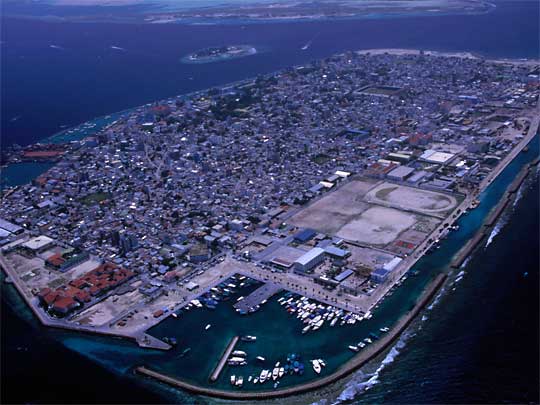 | |||||||||||
| Official languages: Dhivehi | |||||||||||
| Demonym: Maldivian | |||||||||||
| |||||||||||
| |||||||||||
| |||||||||||
| Population | |||||||||||
| - | July 2006 estimate: 350,000 (176th1) | ||||||||||
| - | 2006 census: 298,842 [1] | ||||||||||
| - | Density: 1,105/km² (9th) 2,862/sq mi | ||||||||||
| |||||||||||
| HDI (2007) : ▲0.741 (medium) (100th) | |||||||||||
Currency: Maldivian Rufiyaa (MRf) | |||||||||||
| Time zone: (UTC+5) | |||||||||||
| Internet TLD: .mv | |||||||||||
| Calling code: +960 capital Male' | |||||||||||
The Maldives ([ˈmɒldaɪvz] or [ˈmɒldiːvz], or Maldive Islands), officially the Republic of Maldives, is an island nation consisting of a group of atolls belonging to the Maldive and Suvadive archiplagoes in the Indian Ocean. The Maldives is located south of India's Lakshadweep islands, and about seven hundred kilometres (435 mi) south-west of Sri Lanka. The twenty-six atolls of Maldives' encompass a territory featuring 1,192 islets, two hundred and fifty islands of which are inhabited.
The name "Maldives" may derive from Maale Dhivehi Raajje ("The Island Kingdom [under the authority of] Malé")."[1] Some scholars believe that the name "Maldives" derives from the Sanskrit maladvipa, meaning "garland of islands",[2] or from mahila dvipa, meaning "island of women",[citation needed] but these names are not found in ancient Sanskrit literature. Instead, classical Sanskrit texts mention the "Hundred Thousand Islands" (Lakshadweepa); a generic name which would include not only the Maldives, but also the Laccadives and the Chagos island groups.[citation needed] Another theory suggests that the name "Maldives" derives from the Tamil "mala tivu" meaning "a garland of islands." Some medieval Arab travellers such as Ibn Batuta called the islands "Mahal Dibiyat" from the Arabic word Mahal ("palace")." [3] This is the name presently inscribed in the scroll of the Maldive state emblem.
The inhabitants were Buddhist, probably since Ashoka's period, in the 3rd century BC. Islam was introduced in 1153. The Maldives came then under the influence of the Portuguese (1558) and the Dutch (1654) seaborne empires. And in 1887 it became a British protectorate. In 1965, the Maldives obtained independence from Britain (originally under the name "Maldive Islands"), and in 1968 the Sultanate was replaced by a Republic.
The Maldives is the smallest Asian country in terms of population. It is also the smallest predominantly Muslim nation in the world.
Contents |
History
Comparative studies of Maldivian oral, linguistic and cultural traditions and customs confirm that the first settlers were Dravidian people[4] from the nearest coasts, most probably fishermen from the southwest coasts of the modern Indian Subcontinent and the western shores of modern Sri Lanka during the early Chera period. One such community is the Giraavaru people who claim ancestry from ancient Tamils.[5] One theory suggests that the Giraavaru islanders may not have been the only early settlers in the Maldives. They are mentioned in ancient legends and local folklore about the establishment of the capital and kingly rule in Malé. The Giraavaru people are considered to be one of the earliest communities of settlers on the islands, predating the Christian era and the arrival of Buddhism on the islands.There are some signs of Arab and east Asian inhabitants mostly in southernmost atolls.

Buddhism came to the Maldives at the time of Emperor Ashoka's expansion and became the dominant religion of the people of the Maldives until the 12th century AD.
Western interest in the archaeological remains of early cultures on the Maldives began with the work of H.C.P. Bell, a British commissioner of the Ceylon Civil Service. Bell was shipwrecked on the islands in 1879, and returned several times to investigate ancient Buddhist ruins. He studied the ancient mounds, called havitta or ustubu (these names are derived from chaitiya or stupa) (Mahl: ހަވިއްތަ) by the Maldivians, which are found on many of the atolls.
Although Bell asserted that the ancient Maldivians followed Theravada Buddhism, many local Buddhist archaeological remains now in the Malé Museum display in fact Mahayana and Vajrayana iconography.
According to a legend from the Maldivian Folklore, a prince named Koimala from present day India or Sri Lanka entered the Maldives from the North (Ihavandhu) and, after being welcomed by the Giraavaru people, became the first king from the House of Theemuge. The ancient Maldivian Kings promoted Buddhism and the first Maldive writings and artistic achievements in the form of highly developed sculpture and architecture are from that period. The entire archipelego was conquered by the medieval Chola Tamil emperor Raja Raja Chola I in the early 11th century, becoming a part of the Chola empire. The conversion to Islam is mentioned in the ancient edicts written in copper plates from the end of the 12th century AD. There is also a locally well-known legend about a foreign saint (a Persian from the city of Tabriz or a Moroccan Berber according to the versions) who subdued a demon known as Rannamaari.
Over the centuries, the islands have been visited and their development influenced by sailors and traders from countries on the Arabian Sea and the Bay of Bengal.
Although governed as an independent Islamic sultanate from 1153 to 1968, the Maldives was a British protectorate from 1887 until July 25, 1965. In 1953, there was a brief, abortive attempt to form a republic, but the sultanate was re-imposed. In 1959, objecting to Nasir's centralism, the inhabitants of the three southernmost atolls protested against the government. They formed the United Suvadive Republic and elected, Abdullah Afeef as president and Hithadhoo as capital of this republic.
After independence from Britain in 1965, the sultanate continued to operate for another three years under King Muhammad Fareed. On November 11, 1968, the monarchy was abolished and replaced by a republic, although this was a cosmetic change without any significant alteration in the structures of government. The official name of the country was changed from Maldive Islands to the Maldives in a progressive manner. Tourism began to be developed on the archipelago about five years later, by the beginning of the 1970s.
In November 1988, a group of Maldivians headed by Mr. Lutfee a small time businessman used Tamil mercenaries from Sri Lanka to stage a coup against President Gayyoom. After an appeal by the Maldivian government for help, the Indian military intervened against the mercenaries in order to reinstate Gayyoom in power. On the night of November 3, 1988, the Indian Air Force airlifted a parachute battalion group from Agra and flew them non-stop over 2,000 kilometres (1,240 mi) to the Maldives. The Indian paratroopers landed at Hulule and secured the airfield and restored the Government rule at Malé within hours. The brief, bloodless operation, labelled Operation Cactus, also involved the Indian Navy.
On 26 December 2004, the Maldives were devastated by a tsunami following the 2004 Indian Ocean earthquake. Only nine islands were reported to have escaped any flooding[citation needed], while fifty-seven islands faced serious damage to critical infrastructure, fourteen islands had to be totally evacuated, and six islands were decimated. A further twenty-one resort islands were forced to shut down due to serious damage. The total damage was estimated at over 400 million dollars or some 62% of the GDP. A total of 108 people, including six foreigners, reportedly died in the tsunami. The destructive impact of the waves on the low-lying islands was mitigated by the fact there was no continental shelf or land mass upon which the waves could gain height. The tallest waves were reported 14 feet high.
Economy
In ancient times the Maldives were renowned for the cowries, coir rope, dried tuna fish (Maldive Fish), ambergris (Maavaharu) and coco de mer (Tavakkaashi). Local and foreign trading ships used to load these products in Sri Lanka and transport them to other harbours in the Indian Ocean.
Today Tourism, Maldives' largest industry, accounts for 28% of GDP and more than 60% of the Maldives' foreign exchange receipts. Over 90% of government tax revenue comes from import duties and tourism-related taxes. Fishing is the second leading sector. Agriculture and manufacturing continue to play a lesser role in the economy, constrained by the limited availability of cultivable land and the shortage of domestic labor. Most staple foods must be imported. Industry, which consists mainly of garment production, boat building, and handicrafts, accounts for about 7% of GDP. The Maldivian Government began an economic reform program in 1989 initially by lifting import quotas and opening some exports to the private sector. Subsequently, it has liberalized regulations to allow more foreign investment. Real GDP growth averaged over 7.5% per year for more than a decade. In late December 2004, a major tsunami left more than 100 dead, 12,000 displaced, and property damage exceeding $300 million. As a result of the tsunami, the GDP contracted by about 3.6% in 2005. A rebound in tourism, post-tsunami reconstruction, and development of new resorts helped the economy recover quickly and showed a 18% increase on 2006. Maldives also enjoys the highest GDP per capita $4,600 (2007 est) among south asian countries
Fisheries
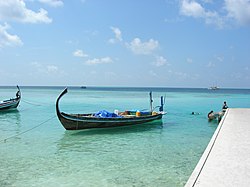
The Maldivian economy was entirely dependent on fishing and other marine products for many centuries. Fishing remains the main occupation of the people and the government gives special priority to the development of the fisheries sector.
The mechanization of the traditional fishing boat called dhoni in 1974 was a major milestone in the development of the fisheries industry and the country's economy in general. A fish canning plant was installed in the island of Felivaru in 1977, as a joint venture with a Japanese firm. In 1979, a Fisheries Advisory Board was set up with the mandate of advising the government on policy guidelines for the overall development of the fisheries sector. Manpower development programs were begun in the early 1980s, and fisheries education was incorporated into the school curriculum. Fish aggregating devices and navigational aids were located at various strategic points. Moreover, the opening up of the Exclusive Economic Zone (EEZ) of the Maldives for fisheries has further enhanced the growth of the fisheries sector. Today, fisheries contribute over fifteen percent of the GDP and engage about thirty percent of the country's work force. It is also the second-largest foreign exchange earner after tourism.
Cottage industries
The development of the tourism sector gave a major boost to the country's fledging traditional cottage industries such as mat weaving, lacquer work, handicraft, and coir rope making. New industries that have since emerged include printing, production of PVC pipes, brick making, marine engine repairs, bottling of aerated water, and garment production.
Politics

Politics in the Maldives takes place in the framework of a presidential republic, whereby the President is the head of government. The President heads the executive branch and appoints the cabinet. The President is nominated to a five-year term by a secret ballot of the Majlis (parliament), a nomination which is confirmed by national referendum.
The unicameral Majlis of the Maldives is composed of fifty members serving five-year terms. Two members from each atoll are elected directly by universal suffrage. Eight are appointed by the president, which is the main route through which women enter parliament. The country introduced political parties for the first time in its history in July 2005, six months after the last elections for the parliament. Nearly thirty-six members of the existing parliament joined the Dhivehi Raiyyathunge Party (the Maldivian People's Party) and elected President Gayoom as its leader. Twelve members of parliament became the Opposition and joined the Maldivian Democratic Party. Two members remained independent. In March 2006, President Gayoom published a detailed Roadmap for the Reform Agenda, providing time-bound measures to write a new Constitution, and modernise the legal framework. Under the Roadmap, the government has submitted to the Parliament a raft of reform measures. The most significant piece of legislation passed so far is the Amendment to the Human Rights Commission Act, making the new body fully compliant with the Paris Principles.
The fifty members of parliament sit with an equal number of similarly constituted persons and the Cabinet to form the Constitutional Assembly, which has been convened at the initiative of the President to write a modern liberal democratic constitution for the Maldives. The Assembly has been sitting since July 2004, and has been widely criticised for making very slow progress. The Government and the Opposition have been blaming each other for the delays, but independent observers attribute the slow progress to weak parliamentary traditions, poor whipping (none of the MPs were elected on a party ticket) and endless points of order interventions. Progress has also been slow due to the commitment of the main opposition party, MDP, to depose President Gayoom by direct action ahead of the implementation of the reform agenda, leading to civil unrest in July-August 2004, August 2005 and an abortive putsch in November 2006. Significantly, the leader of the MDP, Ibrahim Ismail (MP for the biggest constituency - Malé) resigned from his party post in April 2005 after having narrowly beat Dr. Mohammed Waheed Hassan only a couple months earlier. He eventually left MDP in November 2006 citing the intransigence of his own National Executive Committee. The government had engaged the services of a Commonwealth Special Envoy Tun Musa Hitam to facilitate all party dialogue, and when the MDP boycotted him, enlisted the services of the British High Commissioner to facilitate a dialogue. The ensuing Westminster House process made some progress but was abandoned as MDP called for the November revolution.
The Roadmap provides the deadline of 31 May 2007 for the Assembly to conclude its work and to pave the way for the first multi-party elections in the country by October 2008. This deadline has not been achieved.
On 19 June 2006, the Assembly voted to hold a public referendum to decide the form of government under the new constitutional settlement. The resulting referendum has led to the public choosing a Presidential Republic.
Attorney General Dr Hassan Saeed, along with Justice Minister Mohamed Jameel Ahmed resigned from cabinet on 5 August 2007 accusing President Maumoon Abdul Qayyoom of deliberately obstructing reform process in the country which Dr Saeed engineered and spearheaded. Dr Saaed is now running against Qayyoom for the Presidency and is seen as his main opponent.
The political structure of the Maldives has remained practically unchanged for centuries. Despite the passage from Monarchy to republic, the contemporary political structure shows a continuity with the feudal past in which power was shared among a few families at the top of the social structure. In some islands, the offices have remained within the same family for generations. The village is ruled by an administrative officer called Katību, who serves as the executive headman of the island. Above the Katībus of every atoll is the AtoỊuveriya (Atoll Chief). The power of these local chiefs is very limited and they take few responsibilities. They are trained to report to the government about the situation in their islands and to merely wait for instructions from the central power and to follow them thoroughly.[6]
Judiciary
Al Ustaz Mohamed Rasheed Ibrahim from Fuvahmulah is the present chief justice of Maldives. All judges in the Maldives are appointed by the president. Islamic law is the basis of all judicial decisions.
The Maldives have, in cooperation with the United Nations Development Project (UNDP), undertaken to write the world's first Muslim criminal code. This project would formalize the proceedings of criminal justice in this tiny nation to one of the most comprehensive modern criminal codes in the world. The code has been written and awaits action by the parliament.
Meanwhile, Islam remains the only official religion of The Maldives with popular support of the people of the Republic. The open practice of all other religions are forbidden and such actions are liable to prosecution under the law of the country.
Military of Maldives
The Maldives National Defence Force (MNDF) is a combined security force responsible for defending the security and sovereignty of the Maldives, having the primary task of being responsible for attending to all internal and external security needs of the Maldives, including the protection of the Exclusive Economic Zone (EEZ).
Its component branches are:
- MNDF Coast Guard
- MNDF Fire & Rescue Service
- MNDF Infantry Services
- MNDF Defence Institute for Training & Education (Training Command)
- MNDF Support Services
Coast Guard
Maldives being a water bound nation much of the security concerns lay at sea. Almost 90% of the country is covered by sea and the remaining 10% land is scattered over an area of 415km x 120km, with the largest island (altogether 1192 islands) being not more than 8 sq km. The geographic location and formation of the country provides ideal conditions for the moon-cursers to carryout their activities taking Maldives as a covert route to their destinations.
Therefore the duties assigned to the MNDF of maintaining surveillance over Maldives' waters and providing protection against foreign intruders poaching in the EEZ and territorial waters, are immense tasks from both logistical and economic view points. Hence, for carrying out these functions, it is the Coast Guard that plays a vital role. To provide timely security its patrol boats are stationed at various MNDF Regional Headquarters.
Coast Guard is also assigned to respond to the maritime distress calls and to conduct search and rescue operations in a timely manner. Maritime pollution control exercises are conducted regularly on an annual basis for familiarization and handling of such hazardous situations.
Coast Guards also under takes armed sea transport of troops and military equipment around the country.
The Infantry Units of MNDF are named as Quick Reaction Forces, Special Protection Group and Special Forces. They are organized into infantry heavy combat teams and combat groups with amphibious armoured vehicles. They can be mobilized both at land and sea.
QUICK REACTION FORCES (QRF) are established at various strategic locations and vulnerable areas. They are deployed for the purpose of maintaining security in their key areas and they take pride in:
- Assistance to Coast Guard in Maritime operations.
- Assistance to Civil Authorities at times of crisis.
- Search and Rescue operations.
- Providing KP guards.
- Undertaking combat operations.
- Conducting counter insurgency.
- Carrying out counter terrorism operations.
- Supporting humanitarian and disaster relief activities
SPECIAL PROTECTION GROUP (SPG) too undertakes all these responsibilities, but their primary mission remains to protect and safeguard the Head of State as well as visiting dignitaries.
This unit was formally established soon after the 3 November 1988 incident. At first they were known as the Special Guards with a group of well-trained MNDF soldiers. As the force’s tasks and mission expanded, the group was re-named “Special Protection Group” (SPG).
SPECIAL FORCES (SF) is the elitists of the elite cadres of MNDF. They are trained to perform their duties in all conditions at any time, in any part of the country. Specifically their involvement comes in situations where it is impediment to the normal infantry.
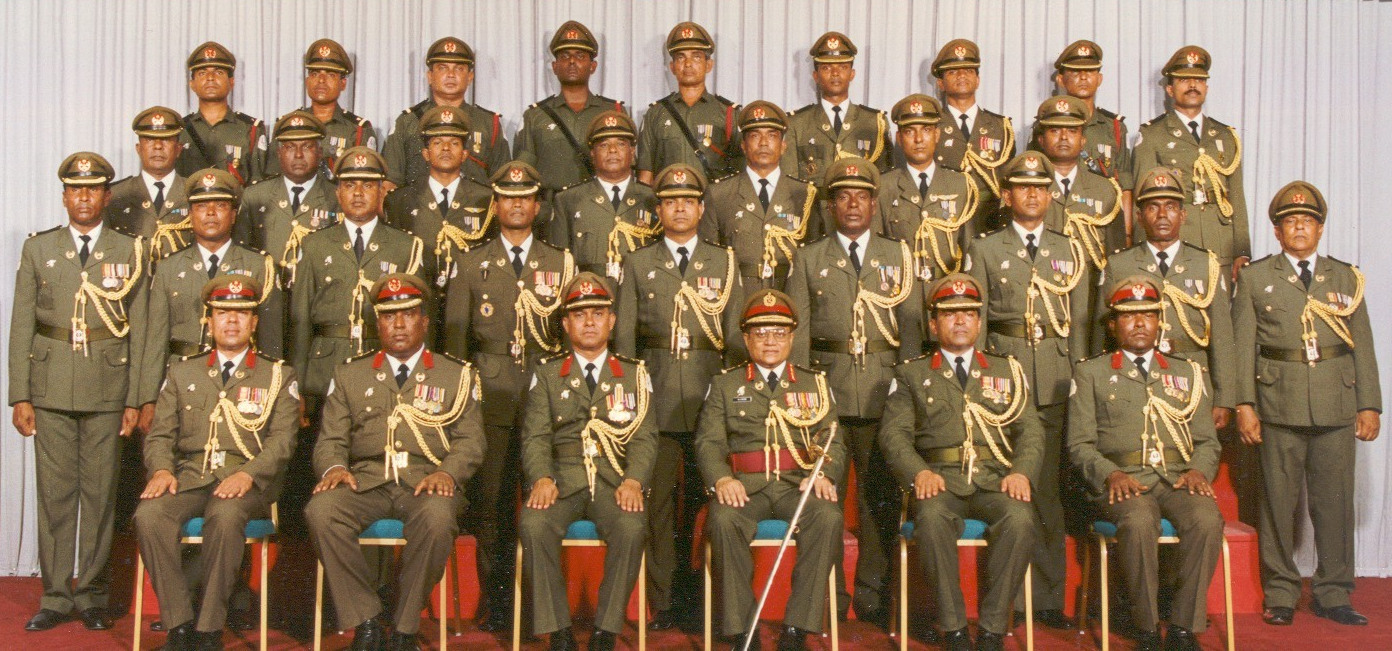
The Maldives and the Indian Ocean Commission
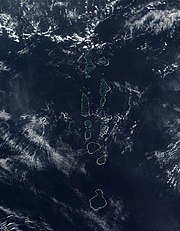
Since 1996, the Maldives has been the official progress monitor of the Indian Ocean Commission. Since 2002, the Maldives has expressed interest in the work of the Indian Ocean Commission but has not applied for membership. The interest of the Maldives relates to its identity as a small island state, especially in relation to matters of economic development and environmental preservation, and its desire to forge close relations with France, a main actor in the IOC region. The Maldives is a founder member of the South Asian Association for Regional Cooperation, SAARC, and as former protectorate of Great Britain, joined the Commonwealth in 1982, some 17 years after gaining independence from Great Britain. The Maldives enjoys close ties with Seychelles and Mauritius, who like the Maldives are members of the Commonwealth. The Maldives and Comoros are also both members of the Organisation of Islamic Conference. The Maldives has refused to enter into any negotiations with Mauritius over the demarcation of the maritime border between the Maldives and the British Indian Ocean Territory, pointing out that under international law, the sovereignty of the Chagos Archipelago rests with the UK, with whom negotiations were started in 1991.
Administrative divisions
The Maldives has twenty-six natural atolls, which have been divided into twenty-one administrative divisions (twenty administrative atolls and Malé city).[7]
In addition to a name, every administrative division is identified by the Maldivian code letters, such as "Haa Alif" for Thiladhunmati Uthuruburi (Thiladhunmathi North); and by a Latin code letter.
The first corresponds to the geographical Maldivian name of the atoll. The second is a code adopted for convenience. It began in order to facilitate radio communication between the atolls and the central administration. As there are certain islands in different atolls that have the same name, for administrative purposes this code is quoted before the name of the island, for example: Baa Funadhoo, Kaafu Funadhoo, Gaafu-Alifu Funadhoo. Since most Atolls have very long geographical names it is also used whenever the name of the atoll has to be quoted short, for example in the atoll website names.[8]
This code denomination has been very much abused by foreigners who didn't understand the proper use of these names and have ignored the Maldivian true names in publications for tourists.[9] Maldivians may use the letter code name in colloquial conversation, but in serious geographic, historical or cultural writings, the true geographical name always takes precedence. The Latin code letter is normally used in boat registration plates. The letter stands for the atoll and the number for the island.
Each atoll is administered by an Atoll Chief (Atholhu Veriyaa) appointed by the President. The Ministry of Atoll Administration and its Northern and Southern Regional Offices, Atoll Offices and Island Offices are collectively responsible to the President for Atolls Administration. The administrative head of each island is the Island Chief (Katheeb), appointed by the President. The Island Chief's immediate superior is the Atoll Chief.
The introduction of code-letter names has been a source of much puzzlement and misunderstandings, especially among foreigners. Many people have come to think that the code-letter of the administrative atoll is its new name and that it has replaced its geographical name. Under such circumstances it is hard to know which is the correct name to use.[8]
Geography
- See also: Atolls of the Maldives
The Maldives holds the record for being the lowest country in the world, with a maximum natural ground level of only 2.3 m (7½ ft), though in areas where construction exists this has been increased to several metres. Over the last century, sea levels have risen about 20 centimetres (8 in); further rises of the ocean could threaten the existence of Maldives.
The first accurate maritime charts of this complex Indian Ocean atoll group were the British Admiralty Charts. In 1834-36 Capt. Robert Moresby, assisted by Lieutenants Christopher and Young, undertook the difficult cartography of the Maldive Islands. The resulting charts were printed as three separate large maps by the Hydrographic Service of the Royal Navy.
A tsunami in the Indian Ocean caused by the 2004 Indian Ocean earthquake caused parts of the Maldives to be covered by sea water and left many people homeless. After the disaster, cartographers are planning to redraw the maps of the islands due to alterations caused by the tsunami.
On April 22, 2008, Maldives President Maumoon Abdul Gayoom pled for a cut in global greenhouse gas emissions, warning that rising sea levels could submerge the island nation of Maldives.[10]
The reef is composed of coral debris and living coral. This acts as a natural barrier against the sea, forming lagoons. Other islands, set at a distance and parallel to the reef, have their own protective fringe of reef. An opening in the surrounding coral barrier allows access to the calmer lagoon waters.
The barrier reefs of the islands protect them from the storms and high waves of the Indian Ocean. The Indian Ocean has a great affect on the climate of the country by acting as a heat buffer, absorbing, storing, and slowly releasing the tropical heat. The heat is further mitigated by cool sea breezes.
A layer of humus six inches thick forms the top layer of soil on the islands. Below the humus layer are two feet of sandstone, followed by sand and then fresh water. Due to excessive salt in the soil near the beach, vegetation is limited there to a few plants such as shrubs, flowering plants, and small hedges. In the interior of the island, more vegetation such as mangrove and banyan grow. Coconut palms, the national tree, are able to grow almost everywhere on the islands and are integral to the lifestyle of the natives.
The limited vegetation is supplemented by the abundance of coral reefs and marine life.
Demographics

The Maldivian ethnic identity is a blend of the cultures reflecting the peoples who settled on the islands, reinforced by religion and language. The earliest settlers were probably from southern India and Sri Lanka.
Some social stratification exists on the islands. It is not rigid, since rank is based on varied factors, including occupation, wealth, Islamic virtue, and family ties. Traditionally, instead of a complex caste system, like the Vedic one, there was merely a distinction between noble (bēfulhu) and common people in the Maldives. Members of the social elite are concentrated in Malé. Outside of the service industry, this is the only location where the foreign and domestic populations are likely to interact. The tourist resorts are not on islands where the natives live, and casual contacts between the two groups are discouraged.
A census has been recorded since 1905, which shows that the population of the country remained around 100,000 for the first seventy years of the last century. Following independence in 1965, the health status of the population improved so much that the population doubled by 1978, and the population growth rate peaked at 3.4% in 1985. By 2007, the population had reached 300,000, although the census in 2000 showed that the population growth rate had declined to 1.9%. Life expectancy at birth stood at 46 years in 1978, while it has now risen to 72 years. Infant mortality has declined from 127 per thousand in 1977 to 12 today, and adult literacy stands at 99%. Combined school enrollment stands in the high 90s.
As of April 2008, more than 70,000 foreign employees live in the country and another 33,000 illegal immigrants sums up more then one third of maldivian population. They consist mainly of people from the neighbouring South Asian countries of India, Sri Lanka, Bangladesh and Nepal.
Language and culture
- See also: Dhivehi language, Dhivehi Writing Systems, Islam in the Maldives, Hinduism in Maldives, Music of the Maldives, and Maldivian Folklore
Maldivian culture is derived from a number of sources, the most important of which are its proximity to the shores of Sri Lanka and southern India. Thus the population is mainly Dravidian from the anthropological point of view.
The official and common language is Dhivehi, an Indo-European language having some similarities with Elu, the ancient Sinhalese language. The first known script use to write Dhivehi is Eveyla akuru script which is found in historical recording of kings (raadhavalhi). Later a script called Dhives akuru was introduced and used for a long period. The present-day written script is called Thaana and is written from right to left. Thaana is said to be introduced by the reign of Mohamed Thakurufaanu. English is used widely in commerce and increasingly as the medium of instruction in government schools.
The language is of Indo-Iranian Sanskritic origin, which points at a later influence from the north of the subcontinent. According to the legends, the kingly dynasty that ruled the country in the past has its origin there.
Possibly these ancient kings brought Buddhism from the subcontinent, but the Maldivian legends don't make it clear. In Sri Lanka there are similar legends, however it is improbable that the ancient Maldive royals and Buddhism came both from that island because none of the Sri Lankan chronicles mentions the Maldives. It is unlikely that the ancient chronicles of Sri Lanka would have failed to mention the Maldives if a branch of its kingdom would have extended itself to the Maldive Islands.[11]
After the long Buddhist [12] period of Maldivian history, Muslim traders introduced Sunni Islam. Maldivians converted to it by the mid-12th century. Islam is the official religion of the entire population, as adherence to it is required for citizenship.
Since the 12th century AD there are also influences from Arabia in the language and culture of the Maldives because of the general conversion to Islam in the 12th century, and its location as a crossroads in the central Indian Ocean.
In the island culture there are a few elements of African origin as well from slaves brought to the court by the royal family and nobles from their hajj journeys to Arabia in the past. There are islands like Feridhu and Maalhos in Northern Ari Atoll, and Goidhu in Southern Maalhosmadulhu Atoll where many of the inhabitants trace their ancestry to released African slaves.[4]
Tourism

The development of tourism has fostered the overall growth of the country's economy. It has created direct and indirect employment and income generation opportunities in other related industries. Today, tourism is the country's biggest foreign exchange earner, contributing to twenty percent of the GDP. There are eighty-seven tourist resorts in operation. The year 2006 recorded 467,154 tourist arrivals.The first tourist resorts were opened in 1972 with Bandos island resort and Kurumba Village.
more info about maldives is available at: http://www.maldives.com/
want to see more pics about maldives pls visit :http://www.lonelyplanet.com/worldguide/maldives/images



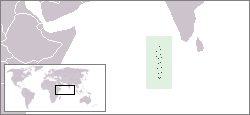

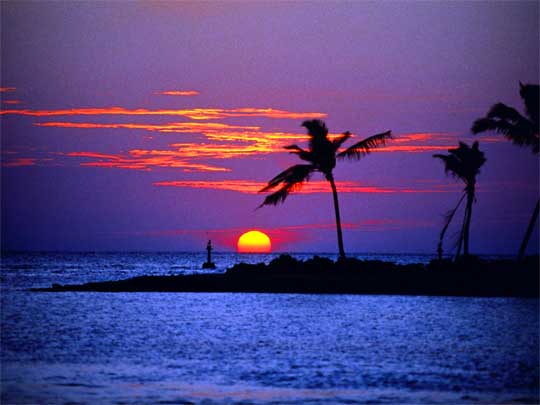

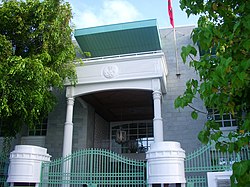






No comments:
Post a Comment